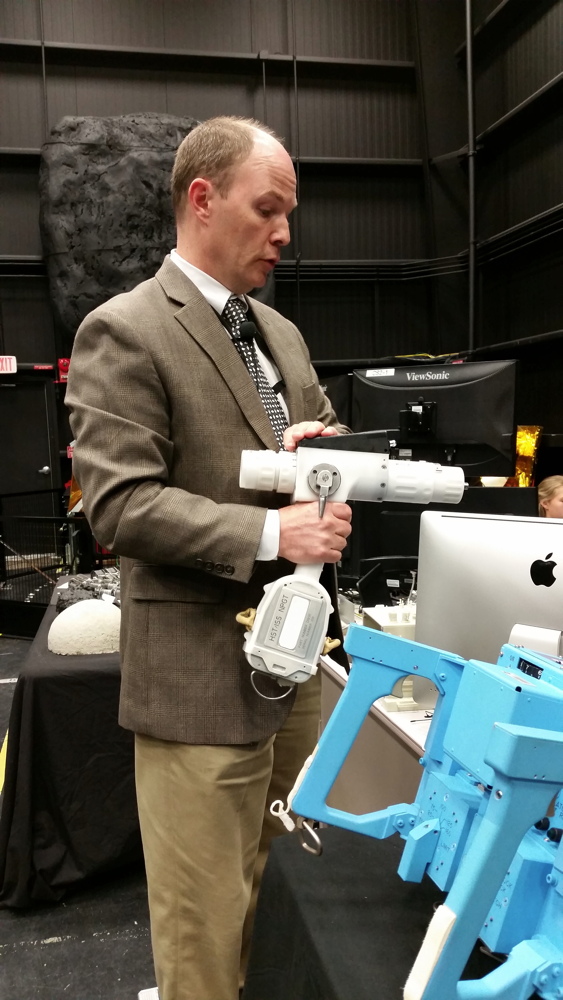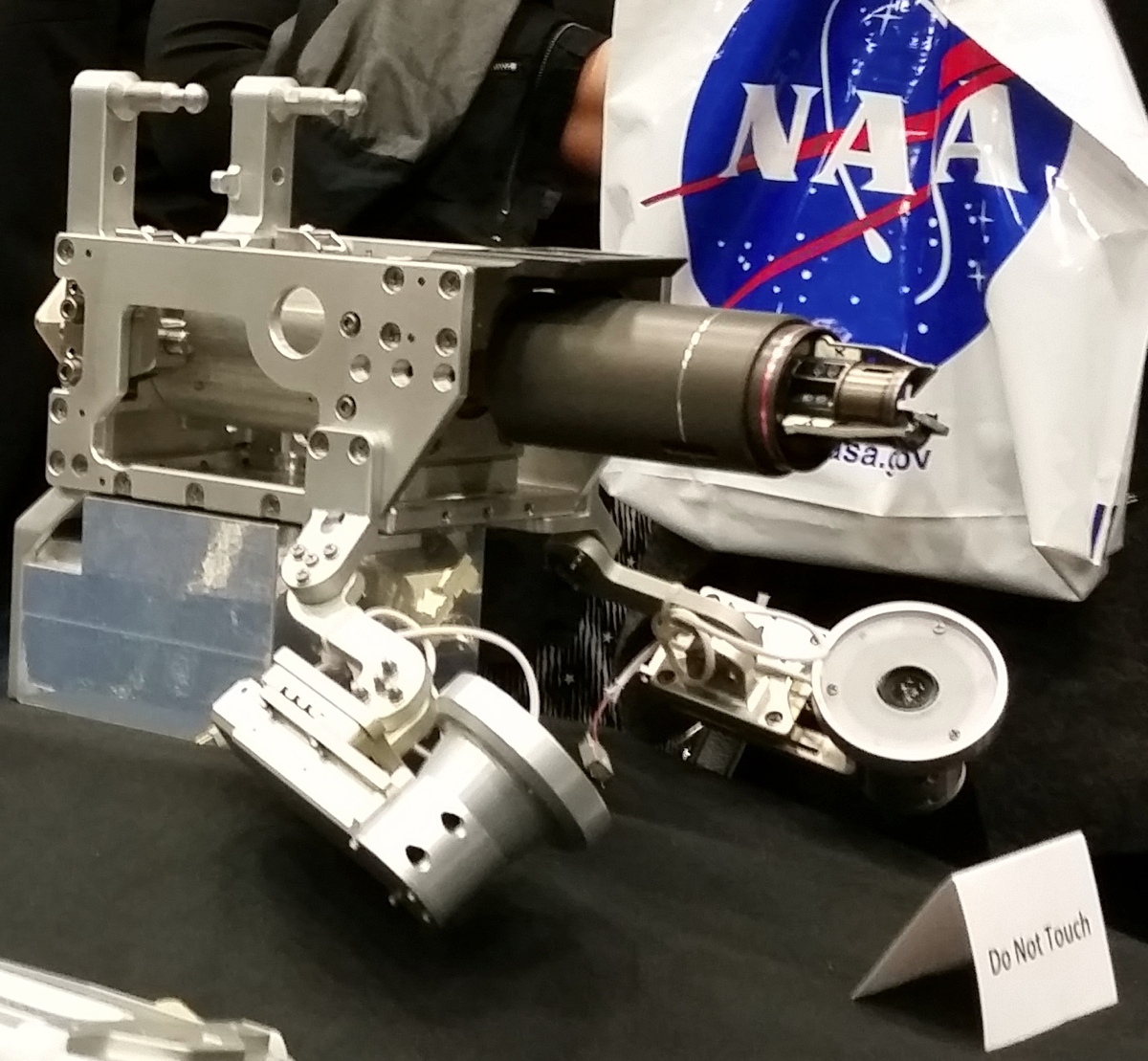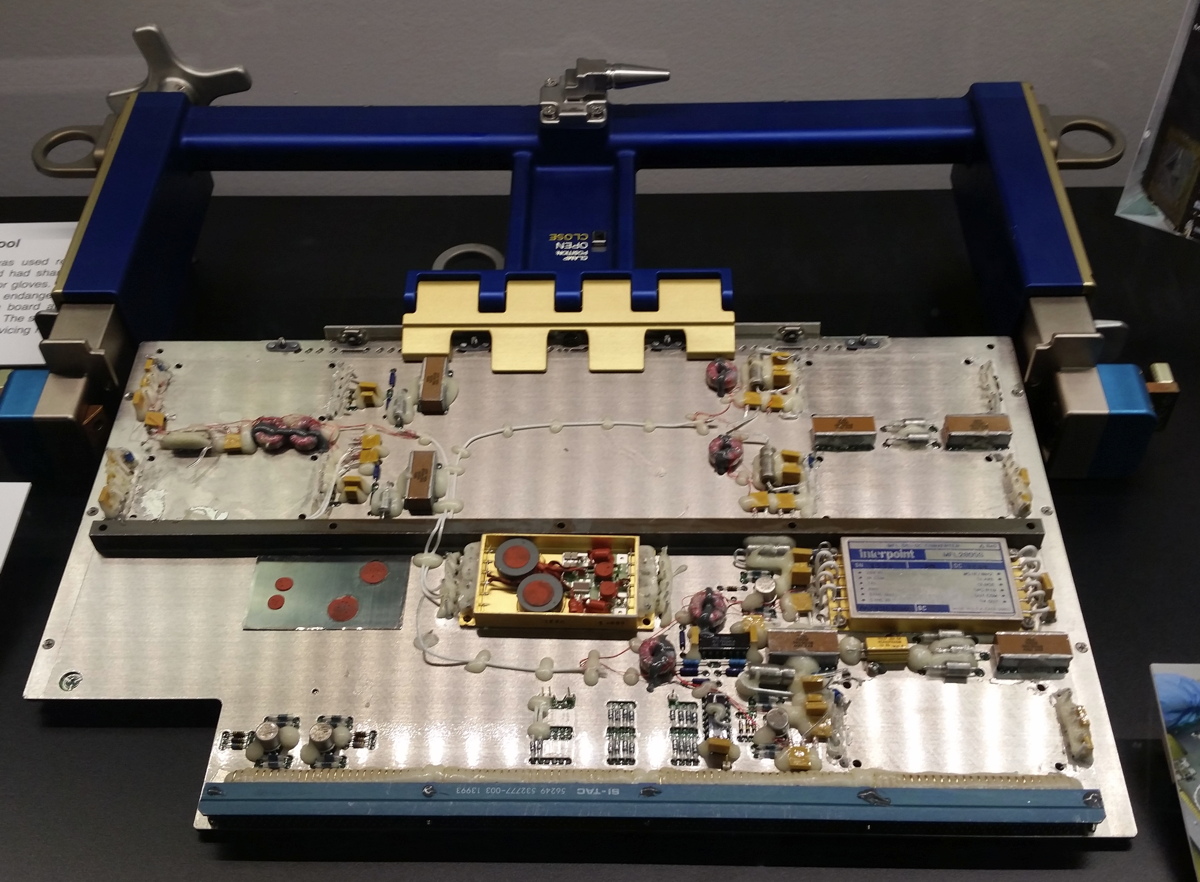Repairing the Hubble Space Telescope: The Tools Astronauts Used

When NASA launched the Hubble Space Telescope on April 24, 1990, the agency already intended to send astronauts up to change out the observatory's scientific instruments from time to time, keeping it at the forefront of science.
But the telescope's builder's also made it flexible enough to accommodate a variety of unforeseen repairs and upgrades — a feature that came in quite handy when it became apparent that Hubble launched with a serious error in its primary mirror that rendered its initial images blurry.
"We designed it to be take-apartable," Russ Werneth said to a group of social media visitors last month at NASA's Goddard Space Flight Center in Greenbelt, Maryland, during an event that celebrated the 25th anniversary of Hubble's launch. [Gallery: The Tools to Keep Hubble Running]
"And more importantly, put-back-togetherable," Ed Rezac added.
Werneth and Rezac, along with Marion Riley, helped design some of the tools that astronauts used to upgrade the Hubble Space Telescope during its last servicing mission. Several of these tools were available for attendees to handle.
'You're going to do what?!'

Astronauts repaired and/or maintained the Hubble Space Telescope during five separate servicing missions between 1993 and 2009. The fifth and final missionnot only required the replacement of mechanical parts and two scientific instruments, but also in-space repairs for two existing instruments.
"The last servicing missionwas one of the most challenging service missions ever completed," Rezac said.
Get the Space.com Newsletter
Breaking space news, the latest updates on rocket launches, skywatching events and more!
In 2004, Hubble's Space Telescope Imaging Spectrograph (STIS) suffered a power failure. Three years later, the Advanced Camera for Surveys (ACS) — the primary camera for the telescope — fell victim to an electrical short. The two instruments had provided significant scientific observations; according to Riley, STIS data had helped generate more scientific papers than any other instrument at the time. So a decision was made to fix STIS and ACSrather than replace them.
"When we first ran the idea past headquarters, the reaction was, 'You're going to do what?!'" Riley said.
Describing the engineers that keep Hubble running, she went on to say, "Every time somebody's told this group, that's impossible, we've said, 'Stand aside.'"
"This is the group that's done the firsts," she continued. "We do it first, and other people follow." [Photos: NASA's Hubble Space Telescope Servicing Missions]

An evolving power drill
One of the biggest changes to the tools used to repair Hubble over the last 25 years came in the form of NASA's electric drill. Bulky spacesuits, astronaut safety concerns, and the cold environment of space all mean that getting screws out of satellites takes a tool that can't be purchased at the local hardware store.
When astronauts serviced the Solar Maximum Mission (SolarMax) satellite in 1984, they used a bulky blue box known as the Module Service Tool (MST). Using two hands to support the MST, astronauts unscrewed retention bolts on SolarMax, removed a broken module and made the necessary repairs.
For the second Hubble servicing missionin 1997, engineers designed a smaller, more compact, Pistol Grip Tool (PGT). The smaller PGT spins about 15 times a minute, and weighs in at only 18 lbs. (8.2 kilograms) on the ground, though the low gravity of space means that weight is less of an issue than bulk and efficiency.
The PGT remains an important part of space construction today, and is still in use on the International Space Station (ISS). In addition to providing the necessary variances in torque, the PGT records the number of turns for each screw in its onboard memory, enabling engineers to accurately plan the time required in future missions. Werneth called the tool "a workhorse on Hubble and the ISS."
Because the last Hubble servicing mission required the removal of more than 100 small screws, the slow speeds of the PGT were insufficient for the task. Engineers needed to build a new instrument to reduce the time astronauts spent in space. The newest power drill weighs only 10 lbs. (4.5 kg), and spins at 210 revolutions per minute. The drill also lacks the torque of the PGT, as the power wasn't necessary for the smaller screws.

'Brain surgery in the dark using oven mitts'
In 2004, the scientifically productive STIS instrument lost power and became inoperable. But its failure didn't have permanent repercussions. Engineers on the ground were able to pinpoint where the problem originated, making it easy to identify what needed to be replaced.
With ACS, things were more difficult. Engineers couldn't determine the precise location of the power failure from the ground. Instead, all of the boards on ACS were replaced, a process that required the removal of more than 32 screws.
None of the Hubble instruments were designed to be repaired in space, only to be replaced. As a result, STIS and ACS were not particularly astronaut-friendly. Still, the failures on both instruments were similar enough that many of the tools used to replace one could be adapted to the other.
According to Werneth, three-time Hubble repair mission astronaut John Grunsfeld, who now serves as associate administrator for NASA's Science Mission Directorate, described the entire repair process as "doing brain surgery in the dark while wearing oven mitts."
To access the electronic cards on ACS, astronauts used what is known as a Grid Cutter Tool to cut through the metal grid. After metal tabs secured the tool, astronauts turned the grid cutter bolts to force 12 blades to cut through the grid.
"The last thing NASA wants you to do is give an astronaut a knife," Rezac said, referring to the space agency's concern for astronaut safety.
Instead, agency officials gave spacewalkers an instrument with 12 knives.
One of the biggest challenges came in the removal of 143 screws from the two instruments — 111 from STIS and 32 from ACS — especially as the screws were not metallic and could not be captured by magnets. Dropping a screw in your garage is annoying; dropping one in space, where it could later collide with and damage Hubble, could be catastrophic.
To capture screws and other debris — including metal shavings potentially created by the grid cutter — engineers developed the "fastener capture plate." Astronauts removed four screws on Hubble to install the plate over the access panel. The plate allowed astronauts to remove screws while the plate contained them. When the astronauts finished, they could remove the entire plate with the screws, leaving no debris or loose screws behind.
With the fastener plates out of the way, astronauts needed to remove the faulty boards from the two instruments. On Earth, engineers might use the oldest of all tools, the human hand, to slide the boards from their boxes. Not so in space, where puncturing a space suit on a sharp edge was a real concern.
"We didn't want John [Grunsfeld] sticking his hand down in there," Rezac said.
Instead, the engineers developed the STIS Card Extraction/Insertion tool, essentially a gigantic robotic arm that gripped the board and slid it out of the appropriate slot, then gripped the new one to slide it in. Large handles made specifically to accommodate the bulk of astronaut gloves simplified the process for the astronauts. [Hubble Space Telescope: Kill Or Save It? (Video)]
The final step was to close the newly repaired scientific instruments back up. The design of the new electronic cards for ACS included a cover, but STIS remained open to the vacuum of space. Rather than require the astronauts to screw in a multitude of tiny screws, engineers developed a new, simplified version of the access panel for STIS that required fasteners. The panel itself was color-coded to make it even more astronaut-friendly.
"You want to make it as easy as possible for the astronauts," Riley said.
Servicing missions of the future
Hubble received its last servicing missionin 2009, but that doesn't mean astronauts won't be taking spacewalks to repair and upgrade other satellites in the future. Hubble's ability to remain on the forefront of science for more than a quarter of a centuryis due in large part to its modularity, which could inspire other missions in the future.
Would the instruments on such missions be more astronaut-friendly? Though it could be possible, Riley doesn't think so. In general, she thinks it is more cost-effective to upgrade an instrument with a new tool rather than attempt to repair it during a spacewalk. However, she says it does depend on how often astronauts intend to service such a satellite.
Even so, designers of today's scientific instruments may have learned from Hubble servicing missions. Although NASA's James Webb Space Telescope (JWST), Hubble's replacement, will be too far away for astronaut visits after its 2018 launch, the day may come when robots could provide repairs, though none are currently planned. As a result, Riley said engineers have asked JWST designers to include decals and other visual clues that could help make it more robot-friendly.
Whether repairs on future instruments are made by robots or by humans, NASA has shown its ability to design the tools needed for the job.
Follow us @Spacedotcom, Facebook or Google+. Originally published on Space.com.
Join our Space Forums to keep talking space on the latest missions, night sky and more! And if you have a news tip, correction or comment, let us know at: community@space.com.

Nola Taylor Tillman is a contributing writer for Space.com. She loves all things space and astronomy-related, and enjoys the opportunity to learn more. She has a Bachelor’s degree in English and Astrophysics from Agnes Scott college and served as an intern at Sky & Telescope magazine. In her free time, she homeschools her four children. Follow her on Twitter at @NolaTRedd









